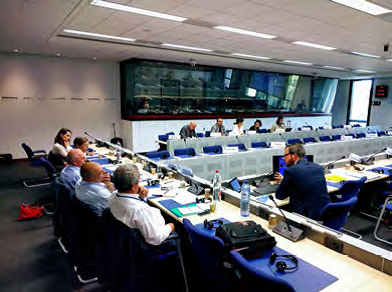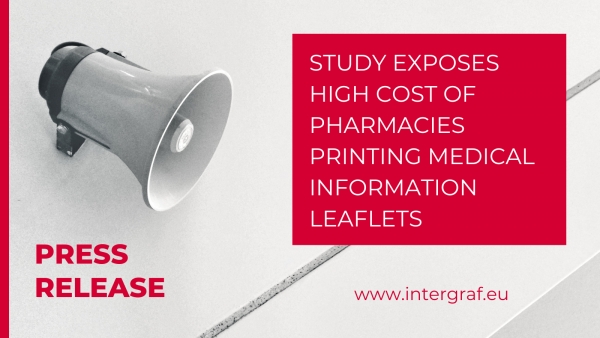December 2018

Printing Industry - views across Europe
At the recent Intergaraf Social Dialogue Working Group, participants gave an overview of the economic situation of the printing industry in their countries. The ensuing discussion was comprehensive and enlightening.
Participants from Portugal, Italy, France, Belgium, the Netherlands, Finland, Germany, Spain, Sweden and Croatia presented the economic situation in their countries at the last Working Group meeting of the Graphical Sector's Social Dialogue Committee. It was made clear that the industry in many countries experiences similar challenges. For instance, the packaging sector is either stable or experiencing an upward trend in most countries. The book market in certain countries - such as France - is also relatively stable, with an value increase of 1% during the last year. Conversely, the graphical printing sector (for the most part) continues to decline.
The printing industry in Europe is made up primarily of SMEs, although the face of the industry is changing. In Belgium and Finland, for example, one key trend is company mergers, resulting in fewer and larger companies. In Finland, the number of printing companies has reduced from 900+ to approximately 720 in recent years. The sector is consolidating, with some companies closing and others merging.
Another common trend for printers across Europe is the increasing cost of materials. Paper prices, for instance, have risen throughout 2018.
The resulting higher production costs are causing problems for some printing companies, who are simultaneously being asked by many publishers to reduce their prices. In some cases, this is causing printers to reach their investment limits. There has also been further increases in costs due to rising energy charges in certain countries. In Portugal, for example, during 2018 there has been an energy hike of approximately 17%, with some printers feeling an increase of closer to 30%. The prices for newsprint, ink, aluminium (printing plates) and isopropanol have also lately increased.
A further area of concern for many countries is the legislative direction of regulations concerning direct mail. In Europe as a whole, direct advertising is viewed much more than electronic advertising. Most digital ads are not viewed at all, and direct mail campaigns frequently have more success driving traffic online to buy products than digital mail. However, legislation at national and local levels in many countries - such as the Netherlands and Belgium - is changing to an ‘opt-in' rather than an ‘opt-out' approach. An opt-in system will prevent many retailers from using direct mail as an advertising tool to contact their customers without their explicit consent. Direct mail printers would be affected by any drop in volumes as a result of this.
Another issue raised was the decreasing use of printed books in schools. In France, for example, almost no schoolbooks are printed. Everything is now digital. And in Croatia, the government has proposed to reduce the number of books used in schools by 30%. This is a concerning trend for printers and society alike. Printers of course risk losing business, but this situation also risks other societal problems. Screen addiction amongst younger people, for instance, is a growing area of concern. The costs of going all digital in schools is also problematic for many families, who are frequently expected to bear the cost of digital devices. For families with lower incomes, this is a real problem.
The printing industry across Europe also has similar needs with regard to recruitment. Image campaigns are important to promote the sector and to show students, and others interested in the industry, the truth about it. Misconceptions about print and paper abound and the new, modern face of the industry needs to be promoted. Digital advancements also make regular upskilling for existing staff very important. Mentorship could also play a more important role in the future.
"Negotiations on graphic paper prices for 2019 have started. Graphic paper producers are claiming for further price increases in 2019. Producers are seeking an increase of 35-40€/tonne for newsprint and SC paper, 30-35€/tonne for CMR, and 8% for UWF and CWF grades."
Laetitia Reynaud, Policy Advisor at Intergraf.
Source: Intergraf Newsflash - December 2018
 Intergraf Economic News (Paper Prices) - March 2024
Intergraf Economic News (Paper Prices) - March 2024
March 2024
Access the latest edition of the Economic Newsletter for the European Printing Industry for data on paper consumption, and pricing data for pulp, paper and recovered paper. Data for packaging papers and board is also available with this edition.
 STUDY EXPOSES HIGH COST OF PHARMACIES PRINTING MEDICAL INFORMATION LEAFLETS
STUDY EXPOSES HIGH COST OF PHARMACIES PRINTING MEDICAL INFORMATION LEAFLETS
March 2024
Intergraf welcomes the release of a study by our partner MLPS (Medical Leaflet = Patient Safety), a subgroup of the European Carton Manufacturers Association (ECMA) shedding light on the potential economic costs associated with the proposed use of Print on Demand (PoD) leaflets in the pharmaceutical legislation revision.










